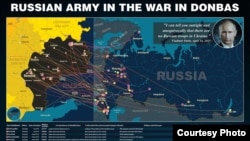Responding to a U.S. State Department statement condemning provocations against international monitors in Ukraine, Kremlin press secretary Dmitry Peskov said Moscow is in “no shape or form a party of the conflict" in Ukraine.
The State Department statement on Sunday, February 26 said: "We condemn Friday's targeting of OSCE (Organization for Security and Cooperation in Europe) special monitoring mission (SMM) monitors and the seizure of an SMM unmanned aerial vehicle by combined-Russian separatist forces."
The statement "called on Russia and the separatist forces it backs to immediately observe the cease-fire, withdraw all heavy weapons, and allow full and unfettered access to the OSCE monitors.”
Despite repeated Kremlin denials, there is an abundance of verifiable documentary evidence of the presence of Russian military hardware, troops, intelligence agents, and economic aid from Russia in the conflict in Ukraine’s Donbas region.
The conflict is approaching its third anniversary and has claimed nearly 10,000 lives.
Direct armed involvement by Russian forces in Ukraine began after Russian special operators seized control of the Crimean Peninsula in early 2014, which had been under Ukrainian control.
Russia’s military, intelligence, financial and technical engagement in the conflict in Ukraine has been reported by numerous sources.
While Russian President Vladimir Putin in February 2014 denied Russia had any part in the Crimean “operation,” he later admitted in April 2014 that Russia’s military intelligence and other personnel were deployed to Ukraine.
Putin asked Parliament to grant permission to send Russian army units into Ukraine and in March 2014 Russia’s Senate approved the request.
Excerpts of recorded phone conversations published by the Ukrainian Prosecutor General’s office in August 2016 indicate that senior Kremlin officials, including top Kremlin advisor Sergei Glazyev and former State Duma Deputy Konstantin Zatulin, managed staged demonstrations, provocations, and armed actions in Southern and Eastern Ukraine.
When questioned by Russian media about the recordings, Glazyev’s response was that he would not “comment on the nonsense of Nazi war criminals."
Igor Strelkov, a former Russian intelligence officer, said in a November 2014 interview that he was responsible for beginning the Donbas conflict by leading attacks against Ukrainian authorities in the city of Slovyansk.
In addition, pro-Ukrainian hackers operating under the name “Cyber-Junta” leaked emails allegedly originating from top Kremlin operative Vladislav Surkov, including some which detailed Surkov’s involvement in the Donbas conflict and in Ukrainian affairs.
At the time, Kremlin spokesman Peskov said Surkov did not use email, apparently ignoring the fact that the account was operated by Surkov's personal assistants. Credible independent analysis found that the metadata in the leaked emails seems to corroborate their authenticity.
There is also evidence of regular Russian army forces operating in Donbas, including video and photos from Russian soldiers and pro-Russian sources showing Russian soldiers and equipment operated exclusively by the Russian military in Donbas. Polygraph.info documented proof of Russia sending tanks into Donbas.
The Minsk II Accords, which set forth an ill-observed ceasefire between Ukrainian and pro-Russian forces in February 2015, mentions a rocket artillery system, the Tornado-S, which is used only by the Russian military.
The citizen journalist site Bellingcat traced a Russian BUK anti-aircraft missile launcher, which likely shot down Malaysian Airlines Flight 17 in July 2014, going from the Russian border into Donbas and back. The site identified the vehicle by its unit within the Russian military.
A comprehensive report on Russian military operations in Donbas was compiled by the Atlantic Council in October 2015.
And a Ukrainian research think-tank, InformNapalm, has created a database detailing Russian military deployment in the Donbas region
NATO, the U.S., Germany and other Western governments have repeatedly called upon Moscow to withdraw its troops from Ukraine and end support for separatists.
On February 18, 2017, Putin issued an executive order recognizing civil registration documents issued by the “government” of the Donbas. The region also declared the Russian Ruble as a state currency.





